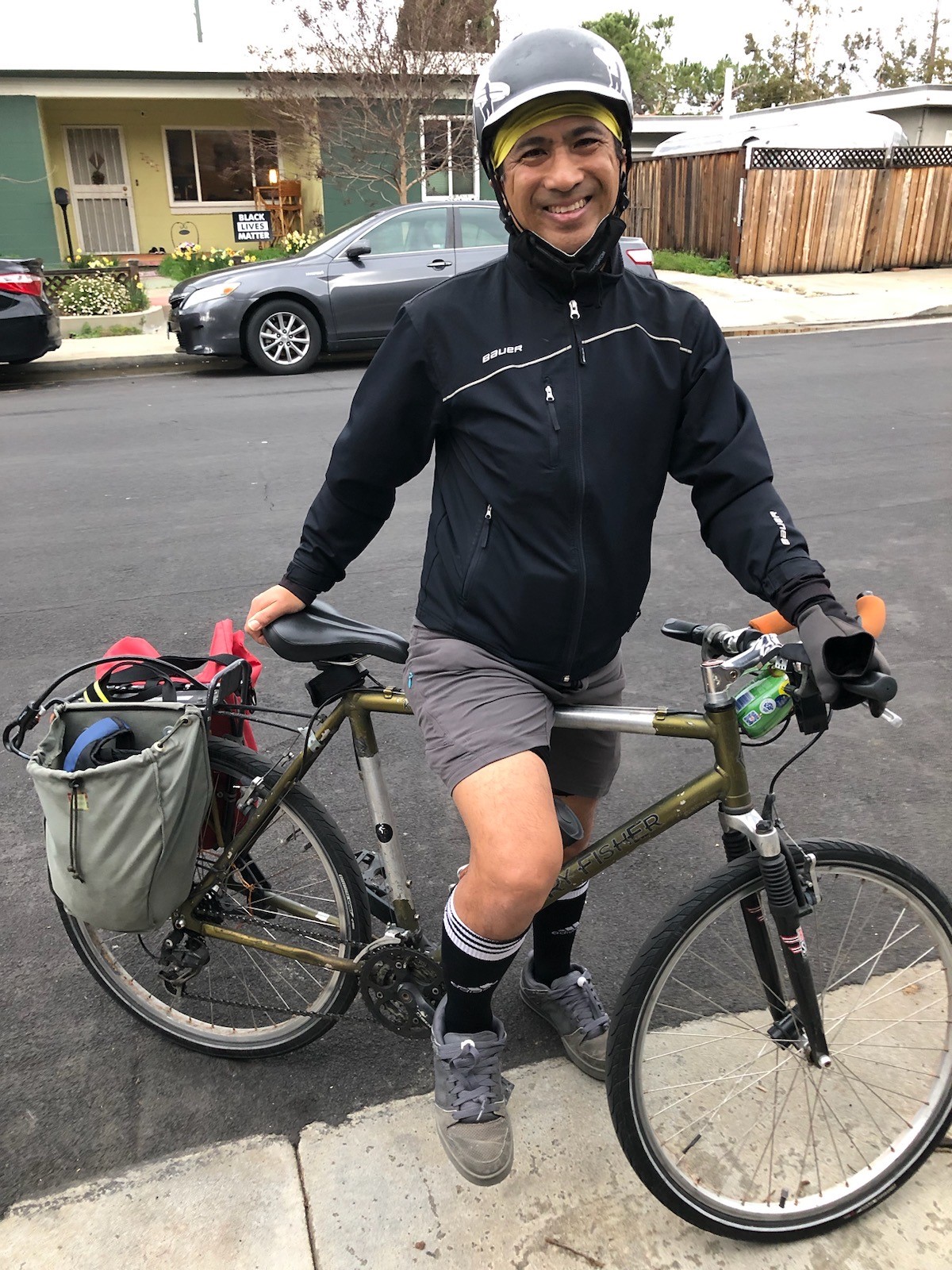[Published: March 15, 2023]
Now that Daylights Saving time has arrived, what will you do with an extra hour of sunshine? Get inspired by Felipe, Donnovan, and Cypress so you, too, can energize your sustainable commute. Here's how these three save money, get healthy, and help the planet.

Felipe Esparza, LBRE Department of Buildings & Grounds Maintenance.
Years ago Felipe’s doctor recommended that he get more exercise. After biking from East Palo Alto to the Stanford campus just once, it was so enjoyable he never looked back. Now, 23 years later, it’s a routine he still loves. In 2018, Felipe transitioned to an e-bike (although he mainly uses pedal power). His three-mile commute takes 20 minutes each way. Although he owns a car, Felipe rides rain or shine. He especially enjoys inclement weather. “I enjoy the raindrops hitting my face and body, watching the trees sway, and the occasional rainbow.”
How much can you save? Crunch the numbers with our Commute Cost & Carbon Emissions Calculator.
Annual Savings: Felipe saves $720/year in parking/gas + additional maintenance savings.
Health benefits: Biking helps control Felipe’s high blood pressure. Regular cycling increases fitness, improves mental health, and lowers stress.
Best benefit from Stanford’s Active Mobility Program: Stanford’s campus infrastructure is geared toward cyclists’ safety. Although Felipe is fortunate to have a secret on campus spot to park his bike, other bike commuters can take advantage of Stanford’s bicycle storage cages.
How he uses the $$ saved: Saving for a rainy day.
Yet Another Reason to Bike, Walk or Take Public Transit to Work
Biking, walking, or taking public transportation to work might offer even more than just great exercise, according to Andrew Huberman, professor of neurobiology and ophthalmology at the Stanford School of Medicine. In the “Master Your Sleep” episode of the Huberman Lab podcast, he noted that between just two and ten minutes of sunlight early in the day and again before sunset can bolster our circadian rhythm and help us fall asleep easily at night.

Donnovan Somera Yisrael, MA ’89, Senior Health Educator, Mental Health and Well-Being, Well-Being at Stanford (A unit of Vaden Health Services.)
If you’ve ever seen a tall man with flowing brown hair inline skating down Palm Drive around commute time, chances are it's Donnovan. An ice hockey aficionado, he mostly bikes to work from Mountain View 3-5 days a week. "It's 6.5 miles door to door, so I get a nice 13-mile bike ride daily,” he said. Donnovan wanted to bike to work for a while but was finally spurred to action after reading one too many heartbreaking climate change stories. “I want to do everything I can to put less carbon into the atmosphere,” he said. An encouraging colleague who initially advised Donnovan on proper rain gear and other logistics was another important factor.
Annual Savings :$990 in parking/gas + additional maintenance savings.
Health benefits: Exercise/endorphins to begin his workday; cardiovascular health; staying in shape, and feeling a part of a community (small-town feel/run into friends); being outside ("Palo Alto and Stanford have some great trees.")
Best benefit from Stanford Transportation: Along with free Stanford-issued Caltrain GoPass and Marguerite, no gym membership necessary.
How he uses the $$ saved: Retirement!
STANFORD & THE IMPORTANCE OF DEI IN THE FUTURE OF BIKING:
One challenge Felipe shared is that there is no bike lane and minimal shoulder on the University Avenue Bridge before he crosses over into East Palo Alto on his return commute.
“Our future work at Stanford as covered in the 2022 report, Pedaling Forward: Bikes at Stanford highlights the current efforts toward building bikeways for people of all ages and abilities, and the importance of Diversity, Equity, and Inclusion,” said Ariadne Delon Scott, assistant director of Active Mobility at Stanford. “We’re committed to helping bridge the gap locally to ensure all campus community members have broad access to the same opportunities and benefits, including sustainable commute choices like bicycling.”

Cypress Wessberg, Zero Waste & Communications Specialist, Office of Sustainability.
Cypress commutes to either the Stanford campus or SRWC campus from San Mateo 3-4 days a week. They ride their bike from home to the Caltrain station. “Caltrain is super efficient. Trains come multiple times a day so if I miss one, there's usually another behind it. For the most part, my sustainable commute is easy,” they said. Cypress owns a lightweight non-electric bike which is easy to carry onto the train. “My favorite thing about my commute is being integrated into the world a bit more, with time to think and experience the world around me.”
Annual Savings: $1,728 in parking/gas + $10K in hidden costs (routine maintenance and repair, insurance, registration, taxes, and depreciation according to AAAʼs “Your Driving Costs August 2022”
Health benefits: Built-in biking exercise on days they don’t do an intentional workout.
Best benefit from Stanford Transportation: “I appreciate that Stanford supports our sustainable commute by providing the Caltrain GoPass. It definitely helps me save a lot of money and reduce my carbon footprint.”
How they use the $$ saved: Roller Derby gear + Bambi the Chihuahua. “I like to joke that I own a dog instead of a car.”
Want to save more? Go car-free and potentially save $10K a year which includes *Hidden commute costs = routine maintenance and repair, insurance, registration, taxes, and depreciation. Source: AAAʼs “Your Driving Costs 2022.”
